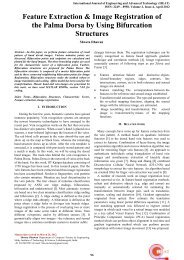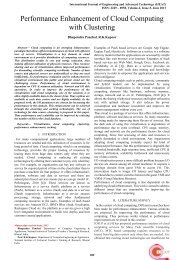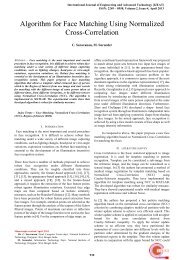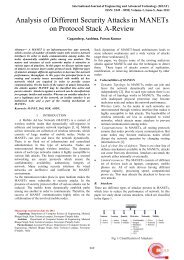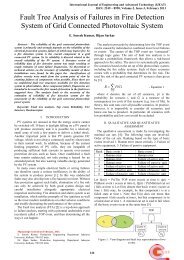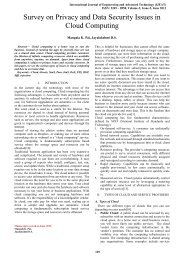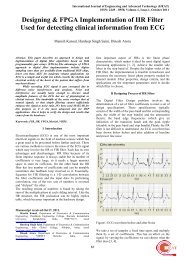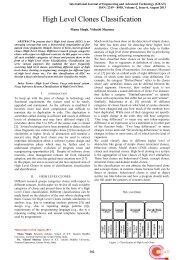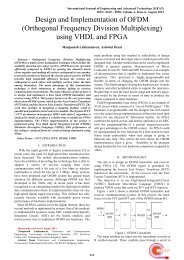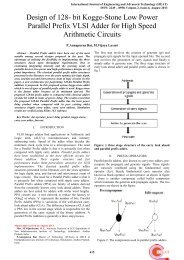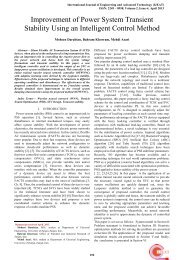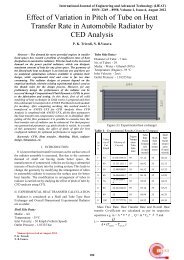Design of C-Band Square Microstrip Patch Antenna with Dual Feed ...
Design of C-Band Square Microstrip Patch Antenna with Dual Feed ...
Design of C-Band Square Microstrip Patch Antenna with Dual Feed ...
Create successful ePaper yourself
Turn your PDF publications into a flip-book with our unique Google optimized e-Paper software.
International Journal <strong>of</strong> Engineering and Advanced Technology (IJEAT)<br />
ISSN: 2249 – 8958, Volume-2, Issue-4, April 2013<br />
<strong>Design</strong> <strong>of</strong> C-<strong>Band</strong> <strong>Square</strong> <strong>Microstrip</strong> <strong>Patch</strong> <strong>Antenna</strong><br />
<strong>with</strong> <strong>Dual</strong> <strong>Feed</strong> for Radar Applications Using ADS<br />
V.Harsha Ram Keerthi , N.Sri pravallika , P.Srinivasulu<br />
Abstract-In the recent years the development in<br />
communication systems requires the development <strong>of</strong> low cost,<br />
minimal weight and low pr<strong>of</strong>ile antennas that are capable <strong>of</strong><br />
maintaining high performance over a wide spectrum <strong>of</strong><br />
frequencies. This technological trend has focused much effort<br />
into the design <strong>of</strong> a microstrip patch antenna. The objective <strong>of</strong><br />
this paper is to design an microstrip line fed rectangular<br />
microstrip patch antenna which operates in C-band at 5GHz.<br />
ADS supports every step <strong>of</strong> the design process—schematic<br />
capture, layout, frequency-domain and timedomain<br />
circuit simulation, and electromagnetic field simulation,<br />
allowing the engineer to fully characterize and optimize an RF<br />
design <strong>with</strong>out changing tools. Therefore, method <strong>of</strong> moments<br />
based ADS s<strong>of</strong>tware is used to design a <strong>Microstrip</strong> <strong>Patch</strong> <strong>Antenna</strong><br />
<strong>with</strong> enhanced gain and bandwidth. Advanced <strong>Design</strong> System<br />
(ADS) continues to lead the RF EDA industry <strong>with</strong> the most<br />
innovative and commercially successful technologies, including<br />
Harmonic Balance, Circuit Envelope, Transient Convolution,<br />
Agilent Ptolemy, X-parameter*, Momentum and 3D EM<br />
simulators (including both FEM and FDTD solvers). With ADS’s<br />
Wireless Libraries and circuit-system-EM co-simulation<br />
technology, ADS provides full, standards-based design and<br />
verification <strong>with</strong>in a single, integrated platform. The length <strong>of</strong> the<br />
antenna is nearly half wavelength in the dielectric it is a very<br />
critical parameter, which governs the resonant frequency <strong>of</strong> the<br />
antenna. In view <strong>of</strong> design, selection <strong>of</strong> the patch width and<br />
length are the major parameters along <strong>with</strong> the feed line<br />
dimensions. Desired patch antenna design was simulated by<br />
ADS simulator program. The entire project is being carried out<br />
at National Atmospheric Research Laboratory (NARL), ISRO.<br />
Key words: C-<strong>Band</strong>, ADS, Micro strip <strong>Patch</strong>, RADAR, Wind<br />
pr<strong>of</strong>iler, dual feed, NARL<br />
I. INTRODUCTION<br />
In this paper the increment in <strong>Band</strong>width and Gain <strong>of</strong><br />
Rectangular <strong>Microstrip</strong> <strong>Patch</strong> antenna which operates at<br />
5GHz has been discussed in details. <strong>Microstrip</strong> patch<br />
antenna has been received tremendous attention since the<br />
last two decades and now it becomes a major component in<br />
the development <strong>of</strong> Wind Pr<strong>of</strong>ile Radar. <strong>Microstrip</strong> antenna<br />
is a printed type antenna consisting <strong>of</strong> a dielectric substrate<br />
sandwiched in between a ground plane and a patch.<br />
Fig1: A Typical <strong>Microstrip</strong> <strong>Patch</strong> <strong>Antenna</strong><br />
In this project Micro strip patch antenna technology is used<br />
for designing <strong>of</strong> the antenna suitable for WPR because <strong>of</strong> its<br />
commercial reality <strong>with</strong> applications in wide variety <strong>of</strong><br />
microwave systems, Personnel communication<br />
system(PCS), wireless local area network (WLAN) etc.<br />
These are preferred over other types <strong>of</strong> radiators because <strong>of</strong><br />
its low pr<strong>of</strong>ile and light weight but its major drawback is its<br />
narrow bandwidth and low gain. This is one <strong>of</strong> the problems<br />
that researchers around the world have been trying to<br />
overcome. In this project, we have tried to increase the gain<br />
and bandwidth <strong>of</strong> the patch antenna. It has been noticed that<br />
there is some significant increments in bandwidth and gain<br />
measurements.<br />
II. FUNDAMENTAL SPECIFICATIONS OF PATCH<br />
ANTENNAS<br />
A micro strip or patch antenna is a low pr<strong>of</strong>ile antenna that<br />
has a number <strong>of</strong> advantages over other antennas it is light<br />
weight, inexpensive, and easy to integrate <strong>with</strong><br />
accompanying electronics. While the antenna can be 3D in<br />
structure (wrapped around an object, for example), the<br />
elements are usually flat hence their other name, planar<br />
antennas.<br />
1. Impedance Matching<br />
Looking at the current (magnetic field) and voltage<br />
(electrical field) variation along the patch, the current is<br />
maximal at the center and minimal near the left and right<br />
edges, while the electrical field is zero in the center and<br />
maximal near the left and minimal near the right edges. The<br />
figures below clarify these quantities.<br />
Manuscript received on April, 2013.<br />
V.Harsha Ram Keerthi, (M.Tech, Communication and Radar systems,<br />
ECE, K.L. University, India)<br />
N.Sri pravallika, (M.Tech, Digital Electronics and Communication<br />
Systems, Sree Vidyanikethan Engineering College, India)<br />
Dr.P.Srinivasulu, (Scientist-SF, National Atmospheric Research<br />
Laboratory, Gadanki, India)<br />
559
<strong>Design</strong> <strong>of</strong> C-<strong>Band</strong> <strong>Square</strong> <strong>Microstrip</strong> <strong>Patch</strong> <strong>Antenna</strong> <strong>with</strong> <strong>Dual</strong> <strong>Feed</strong> for Radar Applications Using ADS<br />
50 Ω. The impedance bandwidth depends on a large number<br />
<strong>of</strong> parameters related to the patch antenna element itself<br />
(e.g., quality factor) and the type <strong>of</strong> feed used. The plot<br />
below shows the return loss <strong>of</strong> a patch antenna and indicates<br />
the return loss bandwidth at the desired (S11/VSWR). The<br />
bandwidth is typically limited to a few percent. This is the<br />
major disadvantage <strong>of</strong> basic patch antennas.<br />
2. Radiation Pattern<br />
The patch's radiation at the fringing fields results in a certain<br />
far field radiation pattern. This radiation pattern shows that<br />
the antenna radiates more power in a certain direction than<br />
another direction. The antenna is said to have certain<br />
directivity. This is commonly expressed in dB. The<br />
rectangular patch excited in its fundamental mode has a<br />
maximum directivity in the direction perpendicular to the<br />
patch (broadside). The directivity decreases when moving<br />
away from broadside towards lower elevations. The 3 dB<br />
beam width (or angular width) is twice the angle <strong>with</strong><br />
respect to the angle <strong>of</strong> the maximum directivity, where this<br />
directivity has rolled <strong>of</strong>f 3 dB <strong>with</strong> respect to the maximum<br />
directivity.<br />
Another approach is to see the patch as a parallel RLC<br />
resonant circuit. This means a phase shift that changes<br />
versus frequency is present, as shown in the following plot:<br />
3 <strong>Antenna</strong> Gain<br />
<strong>Antenna</strong> gain is defined as antenna directivity times a factor<br />
representing the radiation efficiency. This efficiency is<br />
defined as the ratio <strong>of</strong> the radiated power (Pr) to the input<br />
power (Pi). The input power is transformed into radiated<br />
power and surface wave power while a small portion is<br />
dissipated due to conductor and dielectric losses <strong>of</strong> the<br />
materials used. Surface waves are guided waves captured<br />
<strong>with</strong>in the substrate and partially radiated and reflected back<br />
at the substrate edges. Surface waves are more easily excited<br />
when materials <strong>with</strong> higher dielectric constants and/or<br />
thicker materials are used. Surface waves are not excited<br />
when air dielectric is used. <strong>Antenna</strong> gain can also be<br />
specified using the total efficiency instead <strong>of</strong> the radiation<br />
efficiency only. This total efficiency is a combination <strong>of</strong> the<br />
radiation efficiency and efficiency linked to the impedance<br />
matching <strong>of</strong> the antenna.<br />
4 Impedance bandwidth/return loss bandwidth<br />
This is the frequency range wherein the structure has a<br />
usable bandwidth compared to certain impedance, usually<br />
III. OPERATION OF WIND PROFILER<br />
Wind pr<strong>of</strong>ilers depend upon the scattering <strong>of</strong><br />
electromagnetic energy by minor irregularities in the<br />
refractive index <strong>of</strong> air. The reflective index is a measure <strong>of</strong><br />
the speed at which electromagnetic wave propagates through<br />
a medium. Atmosphere is the medium for wind pr<strong>of</strong>iling. A<br />
spatial variation in this index encountered by a radio wave<br />
causes a minute amount <strong>of</strong> energy to be scattered in all<br />
direction. In this atmosphere, minor irregularities in the<br />
refractive index exist over a wide range <strong>of</strong> sizes in the<br />
troposphere and stratosphere. The refractive index depends<br />
primarily on the temperature, pressure and humidity <strong>of</strong> the<br />
air. The radar depends on the scattering <strong>of</strong> EM wave energy<br />
<strong>of</strong> the air associated <strong>with</strong> clear air turbulence (CAT). The<br />
atmosphere minor irregularities in the index refraction exist<br />
over a wide range <strong>of</strong> refraction sizes.<br />
The wind, as it varies in direction or speed produce turbulent<br />
eddies(small whirling currents <strong>of</strong> air). The turbulent eddies<br />
are created over a spectrum <strong>of</strong> sizes ranging from many tens<br />
<strong>of</strong> metres down to centimetres.<br />
560
International Journal <strong>of</strong> Engineering and Advanced Technology (IJEAT)<br />
ISSN: 2249 – 8958, Volume-2, Issue-4, April 2013<br />
Wind pr<strong>of</strong>iler radars are vertically directed pulsed Doppler<br />
radars capable <strong>of</strong> analysing the back-scattered signals to<br />
determine the velocity <strong>of</strong> air along the beams. By steering<br />
the beams typically 15° from zenith, the horizontal and<br />
vertical components <strong>of</strong> the air motion can be obtained.<br />
Radar systems for weather forecasting purposes are to be<br />
accommodated in the frequency allocations <strong>of</strong> the<br />
radiolocation service and/or the meteorological aids service.<br />
Existing uses in these bands need to be protected and<br />
compatibility <strong>with</strong> the services in the adjacent bands has to<br />
be assured. On the other hand, accommodation in the<br />
frequency bands <strong>of</strong> other radio services could be considered,<br />
if this is acceptable from a frequency-sharing point <strong>of</strong> view.<br />
For the identification <strong>of</strong> the various compatibility and/or<br />
sharing options, a clear understanding <strong>of</strong> the concept <strong>of</strong><br />
wind pr<strong>of</strong>iler radar systems and their behaviour in the<br />
electromagnetic environment is needed.<br />
The important applications <strong>of</strong> a conventional Wind Pr<strong>of</strong>ile<br />
Radar lies in (i) Short range forecasting, (ii) Convective<br />
storm initiation, (iii) Climates, (iv) Air Pollution, (v)<br />
Aviation operations and flight planning, and (vi) Rocket and<br />
missile launching etc.<br />
IV. OVERVIEW OF ADS SOFTWARE<br />
ADS(Advance <strong>Design</strong> Systems), 3-D planar EM simulation<br />
s<strong>of</strong>tware for electronics and antenna analysis,<br />
a partial differential equation solver <strong>of</strong> Maxwell's<br />
equations based on the method <strong>of</strong> moments. It is a 3-D<br />
planar electromagnetic (EM) simulator used for<br />
passive analysis. It is a full wave, method <strong>of</strong> moments<br />
(MOM) based electromagnetic simulator for analyzing and<br />
optimizing planar and 3D structures in a multi-layer<br />
dielectric environment. It solves Maxwell's equation in<br />
integral form and its solutions include the wave effects,<br />
discontinuity effects, coupling effects and radiation effects.<br />
The simulated result includes S,Y, and Z-parameters,<br />
VSWR, RLC equivalent circuits, current field distribution,<br />
near and far field estimation, radiation pattern etc.<br />
(b) Wire antennas such as various types <strong>of</strong> dipole,<br />
monopole, helix and quadrifilar antennas.<br />
(c) Small antennas such as inverted-F antennas and its<br />
derivations.<br />
(d) Dielectric resonator antennas.<br />
(e) RFID antennas.<br />
(f) Optical frequency antennas.<br />
(g) Many other types <strong>of</strong> antennas.<br />
V. DESIGN OF A SQUARE PATCH ANTENNA<br />
In this paper, selected parameters are: Resonant Frequency<br />
= 5 GHz(C band), Dielectric material is RT-DUROID5880,<br />
Dielectric constant €r = 2.2, Height <strong>of</strong> the dielectric substrate<br />
h = 1.575 mm. The dimension <strong>of</strong> the <strong>Square</strong> <strong>Patch</strong> is 0.0001<br />
mm layout resolution, tan ∂ = 0.0004<br />
Fig.2: <strong>Patch</strong> Layout structure.<br />
Meshing parameters are Fmax = 6 GHz, N cells = 20 cells/λ,<br />
mesh reduction is normal.<br />
1. The important features <strong>of</strong> ADS S<strong>of</strong>tware:<br />
(a) ADS is EM <strong>Design</strong> Kit for real-time full-wave EM<br />
tuning, optimization and synthesis.<br />
(b) Multi-fold speed improvement and multi-CPU support<br />
for much improved efficiency.<br />
(c) Equation-based schematic-layout editor <strong>with</strong> Boolean<br />
operations for easy and flexible geometry editing and<br />
parameterization.<br />
(d) Lumped element equivalent circuit automatic extraction<br />
and optimization for convenient circuit designs.<br />
(e) Improved integration into Microwave Office from<br />
Applied Wave Research.<br />
2. Applications <strong>of</strong> ADS:<br />
(a) MMIC <strong>Design</strong>.<br />
(b) Signal Integrity Analysis.<br />
(c) RFIC <strong>Design</strong>.<br />
(d) RF & Microwave Board <strong>Design</strong>.<br />
(e) RF System-in-Package & RF Module <strong>Design</strong>.<br />
(g) Many other low to high frequency structures.<br />
3. Applications <strong>of</strong> ADS in <strong>Antenna</strong>s:<br />
(a) Planar antennas such as micro strip antennas and slot<br />
antennas.<br />
Fig.3: Meshed structure<br />
VI. SIMULATED RESULT FOR DIFFERENT<br />
PARAMETERS<br />
Fig. 4: Return Loss vs frequency plot<br />
561
<strong>Design</strong> <strong>of</strong> C-<strong>Band</strong> <strong>Square</strong> <strong>Microstrip</strong> <strong>Patch</strong> <strong>Antenna</strong> <strong>with</strong> <strong>Dual</strong> <strong>Feed</strong> for Radar Applications Using ADS<br />
Fig. 5: Gain & Directivity plot<br />
Fig. 6: 3D Radiation Pattern <strong>of</strong> <strong>Patch</strong> <strong>Antenna</strong><br />
Fig. 7: <strong>Antenna</strong> Parameters<br />
Fig.8 input impedance <strong>of</strong> patch antenna<br />
Fig. 9: Average current distribution <strong>with</strong> colour for the<br />
average strength <strong>of</strong> the current<br />
VII. ADVANTAGE OF WIDE BANDWIDTH FOR<br />
WIND PROFILER APPLICATIONS<br />
A major problem <strong>with</strong> any radar – and a wind pr<strong>of</strong>iler radar<br />
is no exception – is the large required bandwidth. Under the<br />
condition that the separation areas between television<br />
stations operating in the same channel are large enough to<br />
allow the operation <strong>of</strong> a wind pr<strong>of</strong>iler in this channel and in<br />
this separation region, the bandwidth issue is no longer a<br />
major concern because the pr<strong>of</strong>iler could occupy practically<br />
the entire width <strong>of</strong> the TV channel.<br />
• The data rate will be high and therefore the range<br />
resolution is high.<br />
• The pulse compression will be smaller <strong>with</strong> the<br />
increment <strong>of</strong> frequency bandwidth.<br />
• In mobile and broadband communications, it will be<br />
very useful.<br />
• Radiolocation, amateur, space operations, amateursatellite<br />
and aeronautical radiolocation services.<br />
VIII. CONCLUSION<br />
The research motivation <strong>of</strong> this project is to design square<br />
patch antenna for atmospheric Wind Pr<strong>of</strong>ile Radar<br />
application which operates in C-band at 5 GHz. ADS<br />
electromagnetic simulator is used for design and simulation<br />
<strong>of</strong> patch <strong>Antenna</strong>. The square patch antenna <strong>with</strong> 50ohms<br />
line feed has been designed. The impedance bandwidth <strong>of</strong><br />
the designed antenna is 420 MHz, antenna gain is 6.43 dB,<br />
directivity is 7.50, return loss -29dB, the radiation<br />
Efficiency at 5 GHz is about 95% and antenna efficiency is<br />
about 79 %. From the radiation pattern, it is observed that<br />
use <strong>of</strong> amplitude taper maintained the SLL <strong>with</strong>in the<br />
maximum scan angle limit, which is an added advantage for<br />
Atmospheric Wind Pr<strong>of</strong>ile Radar application. The gain and<br />
bandwidth <strong>of</strong> single element patch shows the path <strong>of</strong> further<br />
experiments <strong>with</strong> arrays <strong>of</strong> antennas and in the case <strong>of</strong> dual<br />
polarization.<br />
ACKNOWLEDGMENT<br />
The authors <strong>of</strong> this paper would like to acknowledge all the<br />
corresponding IEEE paper holders and most importantly the<br />
publishers <strong>of</strong> related books and journals which gave<br />
immense support and inspiration in preparing this<br />
manuscript. Above all, the extreme mental support and<br />
source <strong>of</strong> inspiration from all the family members and<br />
friends are widely acknowledged.<br />
562
REFERENCES<br />
[1] Srinivasulu. P, Manas R Padhy, Yasodha. P and NarayanaRao. T,<br />
2010 “Development <strong>of</strong> UHF wind pr<strong>of</strong>iling radar for lower<br />
atmospheric research applications”. Conference paper at NARL.<br />
[2] Srinivasulu. P, Yasodha. P, Rajendra Prasad. T and Narayana<br />
Reddy. S 2010 “Development <strong>of</strong> 1280 MHz Active Array<br />
RADAR at NARL”. Conference Paper at NARL DRAWS-<br />
2010.<br />
[3] C.T.P.Song, P.S.Hall and H.G.Shiraz, “Multiband Multiple Ring<br />
Monopole <strong>Antenna</strong>s” IEEE Trans. on <strong>Antenna</strong>s and propagation,<br />
vol. 51,No.4 pp. 722–729, April. 2003.<br />
[4]. Karaboga, D., K. Guney, S. Sagiroglu, and M. Erler, \Neural<br />
computation <strong>of</strong> resonant frequency <strong>of</strong> electrically thin and thick<br />
rectangular microstrip antennas," IEEE Proceedings | Microwaves,<br />
<strong>Antenna</strong>s and Propagation, Vol. 146, No. 2, 155{159, Apr. 1999.<br />
[5]. Mishra, R. K. and A. Patnaik, \Neural network-based CAD model<br />
for the design <strong>of</strong> square-patch antennas," IEEE Trans. on <strong>Antenna</strong>s<br />
Propagat., Vol. 46, No. 12, 1890{1891, Dec. 1998.<br />
[6]. Patnaik, A., R. K. Mishra, G. K. Patra, and S. K. Dash, \An arti¯cial<br />
neural network model for e®ective dielectric constant <strong>of</strong> microstrip<br />
line," IEEE Trans. on <strong>Antenna</strong>s Propagat., Vol. 45, No. 11, 1697,<br />
Nov. 1997.<br />
[7] R. G. Voughan. 1988. Two-port higher mode circular microstrip<br />
antennas. IEEE, Trans. <strong>Antenna</strong>s Propagat.36(3): 309-321.<br />
[8] D.D.Sandu, O.Avadanei, A.Ioachima, G.Banciua, P.Gasner.<br />
<strong>Microstrip</strong> <strong>Patch</strong> <strong>Antenna</strong> <strong>with</strong> dielectric substrate. Journal<br />
Optoelectronics and Advanced Materials Vol. 5, No. 5, 2003.<br />
V. HARSHA RAM KEERTHI born in India,<br />
1990, he is currently pursuing M.Tech in<br />
Communications & Radar System Engineering<br />
from the Department <strong>of</strong> Electronics and<br />
Communication, K.L University, Vijayawada,<br />
A.P, India. Presently he is carrying out his<br />
project work on <strong>Microstrip</strong> <strong>Patch</strong> <strong>Antenna</strong><br />
<strong>Design</strong> from National Atmospheric Research<br />
Laboratory (NARL), Gadanki. Department <strong>of</strong><br />
Space, Govt.<strong>of</strong> India. He has completed his<br />
B.E in Electronics and Communication from<br />
Saveetha Engineering College <strong>of</strong> Electronics, Anna University, Tamilnadu,<br />
and India.<br />
International Journal <strong>of</strong> Engineering and Advanced Technology (IJEAT)<br />
ISSN: 2249 – 8958, Volume-2, Issue-4, April 2013<br />
N. SRI PRAVALLIKA born in India, 1988,<br />
she is currently pursuing M.Tech in Digital<br />
Electronics and communication system from<br />
the Department <strong>of</strong> Electronics and<br />
Communication, Sree vidyanikethan<br />
Engineering College, Tirupathi, A.P, India.<br />
Presently she is carrying out his project work<br />
on <strong>Microstrip</strong> <strong>Patch</strong> <strong>Antenna</strong> <strong>Design</strong> from<br />
National Atmospheric Research Laboratory<br />
(NARL), Gadanki. Department <strong>of</strong> Space,<br />
Govt.<strong>of</strong> India. She has completed her B.Tech<br />
in Electronics and Communication from<br />
Chadalawada Ramanamma Engineering College, JNTU Ananthapur,<br />
Andhra Pradesh, and India.<br />
Dr. P. S R I N I V A S U L U is presently working<br />
as Scientist-SF at National Atmospheric<br />
Research Laboratory (NARL). He is<br />
involved in the installation a n d<br />
c o m m i s s i o n i n g <strong>of</strong> the VHF Indian<br />
MST Radar and L -band B o u n d a r y Layer<br />
Radar at N AR L. He has expertise on high<br />
power radar transmitters, phased antenna<br />
a r r a y s and receivers. Currently he is<br />
working on leading active array radar projects in<br />
VHF and UHF bands for atmospheric<br />
remote sensing application.<br />
563



